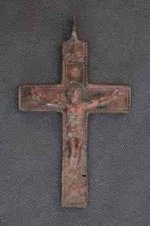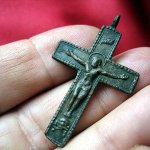pcolaboy
Hero Member
Hunted a friend's dirt pile today and found a beautiful copper/brass cross. I'm not Catholic but it looks like a Rosary chain cross. Can anyone take a crack at identification and age? This same yard has yielded lots of British and Spanish colonial artifacts in addition to American.

Before soap and water

After soap and water

Negative Image

Before soap and water

After soap and water

Negative Image
Pcolaboy

Before soap and water

After soap and water

Negative Image

Before soap and water

After soap and water

Negative Image
Pcolaboy





 . Throughout it's Spanish history, Pensacola's funding and many of its early inhabitants came from Veracruz - not Havana.
. Throughout it's Spanish history, Pensacola's funding and many of its early inhabitants came from Veracruz - not Havana.  In addition, I'm trying to set a good example for my 6 year old son.
In addition, I'm trying to set a good example for my 6 year old son.

 Is it just me or are the french and spanish artifacts the same
Is it just me or are the french and spanish artifacts the same 

